 Image search results - "Imperial" Image search results - "Imperial" |

The Sanno Matsuri Festival is one of Japan's Big Three Festivals and one of Tokyo's Big Three Festivals held in mid-June during several days. The main highlight is the Jinko-sai Procession held every two years. The 600-meter long procession consists of about 500 people parading through central Tokyo near the National Diet, Imperial Palace, Tokyo Station, and Ginza. It includes three portable shrines, carriages, and flower floats. Various events are also held at Hie Shrine which holds the festival. Jinko-sai Procession left Hie Shrine at 8 am on June 11, 2004. Before noon, they approach the Imperial Palace. 山王まつり神幸祭
|
|

The Jinko-sai Procession passes in front of the Imperial Palace.
|
|

For a procession this large and grand, the crowd of spectators was extremely sparse. Good for photographers like me, but it was strange.
|
|
|

Hie Shrine's Sanno Matsuri Jinko-sai Procession in front of Imperial Palace.
|
|
|

One of the three portable shrines.
|
|

The original procession included many high floats. However, due to overhead power lines and overpasses, such floats cannot be included.
|
|
|
|

Omiko Shrine maidens
|
|

Flower float, Sanno Matsuri
|
|
|
|
|

Rest stop near Sakashita-mon Gate at the Imperial Palace.
|
|
|
|

Shrine maidens dance in front of the three portable shrines near Sakashita-mon Gate.
|
|
|
|
|
|
|

During this break period, the shrine priest and other representatives enter the Imperial Palace to pray for the peace, happiness, and prosperity of the Imperial family. Hie Shrine is the only shrine in Japan bestowed with this privilege.
|
|
|

Some entertainment.
|
|
|
|
|
|
|
|
|

The procession passes by Tatsumi Turret as it leaves the Imperial Palace.
|
|
|
|
|
|

A mikoshi passes by Tatsumi Turret of the Imperial Palace durng the Sanno Matsuri Jinko-sai.
|
|
|
|
|
|
|

Road to Tokyo Station.
|
|

Crossing the street.
|
|
|
|

All the auto traffic and urban noise robbed the dignity of the solemn procession.
|
|

In Japanese, the Imperial Palace is called "Kokyo" (皇居). This term begun to be used from 1948. Until then, it was called "Kyujo" (meaning palace castle 宮城)from the time Emperor Meiji took up residence.
|
|

Nijubashi Bridge, the symbol of the Imperial Palace and Tokyo. One of Japan's most famous bridges. There is another bridge behind this one. 二重橋
|
|
|
|
|
|
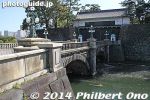
Rear of Nijubashi Bridge.
|
|
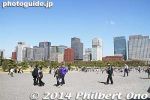
View of Marunouchi office buildings from Imperial Palace.
|
|

View from Nijubashi Bridge. The public can cross the bridge on the Emperor's Birthday (Dec. 23) and Jan. 2 for New Year's.
|
|

Crossing Nijubashi Bridge to enter the Seimon Gate. 正門
|
|

Fushimi Turret as seen from Nijubashi Bridge. Edo Castle was first built by Ota Dokan (太田道灌) in 1457 when Tokyo/Edo was still a small fishing village. Ota Dokan is thus regarded as one of Tokyo's forefathers. 伏見櫓
|
|
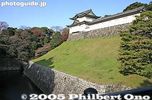
Fushimi Turret. This is what you see when you see Nijubashi Bridge. No one lives in this building. The Emperor's actual residence is not visible from the outside. 伏見櫓
|
|

The Imperial Palace's Chowaden Hall where formal banquets and meetings are held. This modern complex was built in 1968. In front is the Kyuden Totei plaza 長和殿、宮殿 東庭
|
|
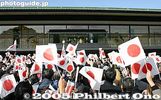
The Emperor and Empress appear on the veranda of this building on his birthday (Dec. 23) and Jan. 2. Well-wishers wave flags in the Kyuden Totei plaza. Also see the video at YouTube.
|
|
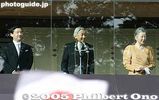
Crown Prince Hiro, Emperor Akihito, and Empress Michiko behind bulletproof glass on the veranda of the Chowaden Hall on the Emperor's Birthday. See more [url=http://photoguide.jp/pix/thumbnails.php?album=158]photos of the Emperor's birthday[/url
|
|

At one end of the Chowaden is Kitakuruma-yose entrance for Japanese dignitaries. 北車寄
|
|

Japanese flag and Fujimi Turret
|
|

Fujimi Turret 富士見櫓
|
|
|

Fujimi Turret, Edo Castle 富士見櫓
|
|

Fujimi Turret. Since Edo Castle had lost its castle tower which was never rebuilt, this turret served the functions of a castle tower. 富士見櫓
|
|
|

Imperial Household Agency is the government agency which controls and manages the affairs of the Imperial family (Emperor, Empress, etc.). 宮内庁
|
|

Map of the East Gardens of the Imperial Palace
|
|

Moat
|
|

Fujimi Turret 富士見櫓
|
|

Fujimi Turret 富士見櫓
|
|

Fujimi Turret 富士見櫓
|
|

Fujimi Turret 富士見櫓
|
|
|
|

Fujimi Turret 富士見櫓
|
|
|

Behind Fujimi Turret 富士見櫓
|
|

Behind Fujimi Turret
|
|

Moat
|
|
|

Honmaru, Edo Castle's main keep. See the castle tower's foundation on the lower right. 本丸
|
|

Castle tower's foundation on the lower right.
|
|

The original castle tower or donjon was completed in 1607 and later renovated in 1638 under Shogun Tokugawa Iemitsu as Japan's tallest castle tower at 58 meters (5 stories high).
|
|

Foundation of castle tower or donjon. In 1657, there was a great fire in Edo and a stray ember set the castle tower on fire and destroyed it only 19 years after it was built. It was never rebuilt. 天守台
|
|
|

Going up the castle tower foundation.
|
|
|
|
|
|

Going up the castle tower foundation.
|
|
|
|

View from castle tower foundation.
|
|

Top of castle tower foundation.
|
|

View of Kitahanebashi-mon Gate
|
|
|
|
|

Side view of castle tower foundation.
|
|

Corner of castle tower foundation.
|
|

Corner of castle tower foundation.
|
|

Moat behind castle tower foundation.
|
|

Moat as seen from Kitahane-bashimon Gate
|
|

Kitahane-bashimon Gate. Right behind the castle tower foundation. 北桔橋門
|
|

Otemon Gate, Edo Castle's main gate. 大手門
|
|
|
|

Weeping cherry blossoms near Otemon gate.
|
|
|
|
|
|

Otemon Gate 大手門
|
|

Otemon Gate 大手門
|
|
|

Doshin Bansho Guardhouse where guards kept watch on the entourage of daimyos visiting the castle. 同心番所
|
|

Hyakunin Bansho Guardhouse where 100 samurai guards guarded the entrance to the Honmaru, the castle's main keep. 百人番所
|
|
|
|

Daibansho Guardhouse 大番所
|
|
|
|
|
|

View of Hakucho moat from Shiomizaka Slope 汐見坂 白鳥濠
|
|
|

Tatsumi Turret 翼櫓(桜田二重櫓)
|
|

Tatsumi Turret 翼櫓(桜田二重櫓)
|
|
|

Tatsumi Turret, also called Sakurada-Niju Turret 翼櫓(桜田二重櫓)
|
|
|

Tatsumi Turret was used for defense with holes to drop stones and windows to shoot arrows. 翼櫓(桜田二重櫓)
|
|
|
|
|

桔梗門
|
|
|
|

Sakashita-mon Gate 坂下門
|
|

Sakashita-mon Gate, closest to the Imperial Household Agency and entrance to Inui-dori, a 600-meter path lined with cherry blossoms. 坂下門坂下門
|
|
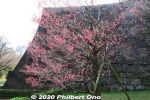
The Imperial Palace also has some plum blossoms near Hirakawa Gate. Blooming in Feb.
|
|
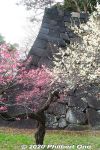
Plum blossoms at the Imperial Palace.
|
|
|
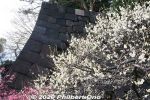
Plum blossoms at the Imperial Palace.
|
|

Plum blossoms at the Imperial Palace.
|
|
|
|
|
|

Blizzard of white plum blossoms at the Imperial Palace.
|
|
|
|
|
|
|
|
|
|
|
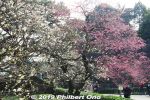
Plum blossoms at the Imperial Palace.
|
|
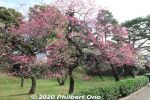
Plum plossoms near Hirakawa Gate.
|
|
|
|
|
|
|

Hirakawa Gate at the Imperial Palace.
|
|

Hirakawa Gate at the Imperial Palace.
|
|

Police vans during cherry blossom season when they opened Inui-dori to the public in late March to April 3, 2016. 皇居乾通り一般公開
|
|

People going to Inui-dori. Since 2014, they opened the path to the public for only several days during the sakura and fall foliage periods.
|
|

I looked at this line and thought it would take at least an hour to get in. It was a hot, sunny day at 20 C on March 31, 2016 at 10:15 am.
|
|

Long line to enter Inui-dori, a 600-meter path lined with cherry trees along a palace moat. 皇居乾通り一般公開
|
|

They started another line of people.
|
|

It seemed that it was going to take forever to get in.
|
|

Policeman was shouting that people with no bags to be checked can go through a different (faster) line.
|
|

After waiting for about 15 min. in the heat, just when I seriously thought about giving up and going home, the line moved forward to the checkpoint where they checked our bags and gave us a body check. It was quick and easy.
|
|

Wow, amazing that we could get in so quickly. This was the entrance to Inui-dori, Sakashita Gate.
|
|

Sakashita Gate
|
|
|

Sakashita Gate on the other side.
|
|

Imperial Palace Chowaden, where formal banquets are held and where the Imperial family appears in public for New Year's and Emperor's Birthday.
|
|

On this fine day on March 31, 2016, 66,950 people visited Inui-dori. During March 25–April 3, 2016, a total of 508,010 visited Inui-dori.
|
|

Pass by the Imperial Household Agency. They control the lives of the Imperial Family.
|
|

Imperial Palace Fujimi turret and Marunouchi office buildings. Tradtional vs. modern.
|
|
|

Inui-dori is a somewhat narrow paved path along a moat. It has small cherry trees and autumn foliage.
|
|
|

Fujimi Tamon, defense house. 富士見多聞
|
|

It was still too early, about 2-3 days before full bloom. But this was the last sunny day before clouds and rain that were forecast.
|
|

Fujimi Tamon, defense house. 富士見多聞
|
|

In spring 2016, cherry blossoms in Tokyo took 9 days to reach peak bloom due to the warm winter. Longer than usual. So they extended the days when the public can see Inui-dori.
|
|
|
|

Long house
|
|
|

Weeping cherry tree, too early.
|
|

Fujimi Tamon, defense house. 富士見多聞
|
|

Lots of people, but very civil. No pushing or shoving. No time limit either. I took my time, taking pictures.
|
|

Dokan Moat, named after the founder of Edo Castle.
|
|

Dokan moat
|
|

Midway, there is a bridge to go to the garden area.
|
|
|

Inui-dori is overrated. But because it's the Imperial Palace and the path is not normally open to the public, it has the image of exclusivity so lots of people want to see it.
|
|

They will do major gardening work from this year, so Inui-dori will not be open this fall and next spring. Have to wait until fall 2017 to see this again.
|
|
|
|
|

Cherry blossoms on Inui-dori, Imperial Palace
|
|
|

Cherry blossoms on Inui-dori, Imperial Palace
|
|
|
|
|
|
|
|

Cherry blossoms on Inui-dori, Imperial Palace
|
|

Cherry blossoms on Inui-dori, Imperial Palace
|
|

The exit at Inui Gate
|
|
|

Inui Gate
|
|

Inui Gate from the outside.
|
|

After Inui-dori, turn left and walk to Chidorigafuchi to see more cherry blossoms.
|
|

Moat near Sakashita-mon Gate
|
|
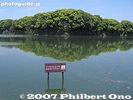
Corner of moat
|
|
|

Sakuradamon Gate 桜田門
|
|

Sakuradamon Gate, near here was where Lord Ii Naosuke from Hikone was assassinated. 桜田門
|
|

Sakuradamon Gate 桜田門
|
|

Sakuradamon Gate 桜田門
|
|

Sakuradamon Gate
|
|

Sakuradamon Gate
|
|

Sakuradamon Gate, rear view
|
|
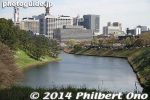
Sakurada Moat
|
|
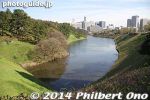
Sakurada Moat
|
|
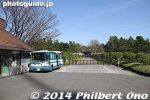
Hanzomon Gate is guarded. This is the closest gate to the Emperor's residence. This is where they normally enter and leave the palace.
|
|
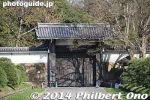
Hanzomon Gate, Imperial Palace, Tokyo
|
|
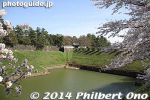
Hanzomon Gate
|
|
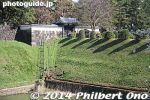
Hanzomon Gate
|
|
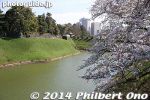
Hanzo Moat with Hanzomon Gate in the distance.
|
|
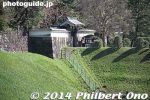
Hanzomon Gate
|
|
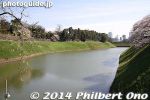
Hanzo Moat, near Hanzomon Gate.
|
|
|
|
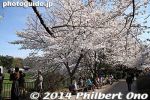
Cherry blossoms along Hanzo Moat.
|
|
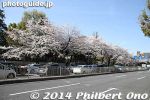
Cherry blossoms in front of British Embassy near Hanzomon.
|
|
|
|
|
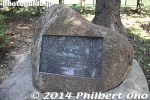
Marker for an old high school.
|
|
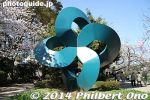
Mexican monument
|
|
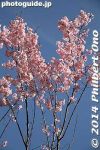
Maihime cherry blossoms 舞姫
|
|
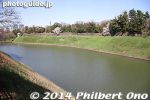
Hanzo Moat
|
|
|
|
|
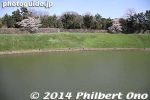
Hanzo Moat, near Hanzomon Gate.
|
|
|
|

Chidorigafuchi
|
|

Chidorigafuchi 千鳥ヶ淵
|
|

Chidorigafuchi with the roof of Budokan visible.
|
|
|
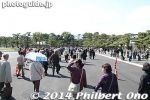
For the first time, they allowed the public to enter the Imperial Palace to view cherry blossoms along a short path called Inui-dori during April 4-8, 2014.
|
|
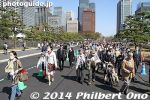
What happened was, tens of thousands of people showed up. On the first day April 4, 2014, over 55,000 people came to see the Inui-dori sakura.
|
|
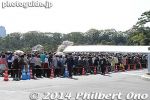
People waited 2-3 hours to get in and underwent body searches. I arrived at 2 pm and it was too late to get in.
|
|
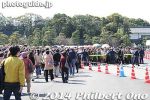
Insane crowds at Imperial Palace on April 4, 2014.
|
|
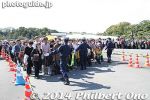
It was worse during the weekend.
|
|
|
|